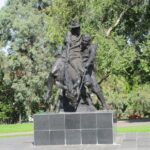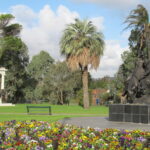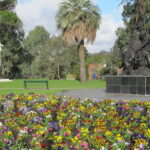The iconic figure of ‘Simpson and his Donkey’ looks towards War Memorial Drive from the Angas Garden. The life-size statue was erected to honour Australian Defence Force health workers. John ‘Jack’ Simpson Kirkpatrick, who served as Private Simpson, survived just three and a half weeks at Gallipoli in 1915. He was a stretcher bearer with the Australian and New Zealand Army Corps (ANZAC) in the First World War. Simpson’s story, and the image of him ferrying the wounded through ‘Shrapnel Gully’, has come to represent the spirit of ANZAC soldiers for many Australians.
The Man
John Simpson Kirkpatrick was born in England on 6 July 1892. At age 17 he joined the Merchant Navy, which he deserted in 1910 at Newcastle in New South Wales. For the next four years he worked in a variety of jobs around Australia, including as cane cutter, stationhand and miner. By 1914 he had made his way to Perth, where he enlisted as John Simpson. Assigned to the 3rd Field Ambulance in the Australian Army Medical Corps, Simpson was sent to Egypt in November that year.
Australian troops, including Simpson, landed at Gallipoli on 25 April 1915. Private Simpson became well recognised as he helped wounded men on his donkey from the fighting in ‘Monash Valley’ through ‘Shrapnel Gully’ to the beach that is now known as ANZAC Cove. Simpson is reported to have saved more than 300 men. His route was frequently under fire, and despite the protected status of medical personnel, he was shot dead on 19 May.
The Statue
The statue of ‘Simpson and his Donkey’ was officially unveiled on 9 February 2012 by Governor Kevin Scarce. Originally commissioned in 2007, it was created by sculptor Robert Hannaford who made several models before the final bronze statue. Memorials featuring Simpson include one in Canberra and another in Melbourne. He was chosen as the subject for a memorial in Adelaide in part because of the strong South Australian link with the Australian Army Medical Corps. Adelaide was home to the 3rd Field Ambulance from the First World War until 1995.
There was some debate over the final location of the statue, in the Angas Garden, near the intersection of King William Road and Sir Edwin Smith Avenue. The Adelaide Parklands Preservation Association and the Heritage Unit of the then Department of Environment and Heritage raised concerns that the statue would obscure the memorial to George Fife Angas, after whom the garden was named. Opponents argued that the Returned and Services League of Australia (SA Branch; RSL) initially suggested a site near the Royal Adelaide Hospital. Later there was discussion about locating it near the Torrens Parade Ground, but the RSL and the Simpson Foundation, which had raised the funds for the statue, agreed on the current location as the preferred option. This site has the advantage of being on the route of the Anzac Day march, allowing the marchers to give an ‘eyes right’ salute to the memorial honouring fallen comrades.







Comments